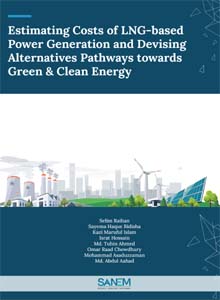Estimating Costs of LNG-based Power Generation and Devising Alternatives Pathways towards Green and Clean Energy
 Citation: Raihan, S., Bidisha, S. H., Islam, K. M., Hossain, I., Ahmed, M. T., Chowdhury, O. R., Asaduzzaman, M., and Aahad, A. (2024). Estimating Costs of LNG-based Power Generation and Devising Alternatives Pathways towards Green and Clean Energy. SANEM Publications, Dhaka, Bangladesh.
Citation: Raihan, S., Bidisha, S. H., Islam, K. M., Hossain, I., Ahmed, M. T., Chowdhury, O. R., Asaduzzaman, M., and Aahad, A. (2024). Estimating Costs of LNG-based Power Generation and Devising Alternatives Pathways towards Green and Clean Energy. SANEM Publications, Dhaka, Bangladesh.
The power and energy sector of Bangladesh is currently being challenged by newer obstacles imposing its inherent structural and institutional vulnerabilities despite of notable achievements. Volatility in the global energy market, notably from the Russia-Ukraine conflict, pressures the government budget which is evident from the financial pressure on the BPDB. As domestic gas reserves deplete, leading to plans for expanded LNG imports and infrastructure development, the country becomes more vulnerable to fluctuations in global energy prices. In this situation, a comprehensive assessment of alternatives is crucial for an optimal energy mix. Amidst this backdrop, this report explores and assesses the cost-effectiveness of the available options thoroughly to understand and select the optimal energy mix available for the country.
In terms of energy sources, Bangladesh heavily relies on fossil fuels, with gas accounting for the majority. While the country has potential in solar and wind energy, their contribution remains low, prompting initiatives to expand renewable capacity. Bangladesh’s development journey has witnessed a growing demand for electricity in industrial and agricultural sectors, resulting in a significant increase in electricity generation capacity over the past decade. Nonetheless, despite having addressed generation shortages as a blackout cause, load-shedding due to transmission constraints and distribution network overloads remains a frequent obstacle to economic activities. The country has also felt the impact of the recent global energy crisis, which has been further exacerbated by the ongoing dollar crisis within the economy. Even after adding 669 MW in FY2021-22, demand remains unmet due to rapid urbanization and industrialization. Notable issues include high-capacity payments for underutilized coal plants, overcapacity despite idle facilities, and cancelled coal projects amid global trends. The dependence on imported energy, insufficient renewable options, inadequate investment, and burdening subsidies pose further hurdles. Frequent tariff increases, outdated technology, and workforce skill gaps accentuate the sector’s complexities.
The global LNG market is witnessing increased demand from both emerging and developed markets, leading to substantial investments in LNG processing and transport infrastructure. Global LNG investments are expected to peak at $42 billion in 2024, driven by the escalating global energy crisis. LNG supply is projected to nearly double by 2030, from 380 million tons per annum (MTPA) in 2021 to about 636 MTPA. Despite fluctuations in LNG trade due to factors like the Russian-Ukraine conflict and COVID-19, Europe’s LNG demand surged, impacting global supply and causing price volatility. While the focus on energy security shifts LNG trade patterns, future markets predict varying prices influenced by global events, such as China’s energy demand growth.
Bangladesh has been affected significantly by the global energy crisis and global LNG price and supply volatility. Despite attempting to continue imports, the country had to halt at a certain point in 2022, leading to the government’s adoption of precautionary load-shedding measures. The escalating reliance on imported fossil fuels for power generation exacerbates energy sector volatility, compounding the nation’s fiscal strain and precipitating hikes in fossil fuel prices. The impacts extend to foreign currency reserves and substantial subsidy burdens. Compounded by declining foreign reserves, the feasibility of government-led projects becomes a concern, eroding companies’ trust in the state’s capability to finance spot market LNG imports. The energy crisis also holds political economy implications, fostering a focus on short-term gains over long-term stability. Consequently, the government faces a heavier subsidy burden, necessitating increased allocation of funds to the power and energy sector. Concurrently, overcapacity issues hinder substantial investments in the renewable energy sector’s expansion in the near future.
Against this backdrop, this study aims at exploring a sustainable pathway towards green and clean energy for Bangladesh. In particular, given the country’s heavy reliance on LNG and particularly on imported LNG, it is important that the available alternatives are duly explored and evaluated for understanding and choose the best energy mix available for the country. Through a critical analysis of alternative energy sources, this study, in particular aims at (i) estimating the economic and financial costs of reliance on LNG imports and their implication for the economy and (ii) exploring alternative pathways to LNG imports, especially renewable energy, to have a better understanding of Bangladesh’s comparative advantage in this regard.
On the basis of the cost estimation, comparison and energy sources’ analysis our study suggests that Bangladesh’s pursuit for energy security amid frequent power outages need a strategic shift. The vulnerabilities of imported fossil fuels underscore the need for self-reliance. A focus on domestic gas exploration is necessary to curtail costly LNG imports, while uncharted deep offshore exploration holds untapped potential. About renewables, harnessing Bangladesh’s abundant 4.5 hours of daylight efficiently and tapping into wind resources can significantly reduce load shedding and reliance on fossil fuels, aligning with clean energy goals. Comparing LNG and solar investments reveals solar power’s long-term cost-effectiveness and environmental advantages. Furthermore, repurposing inefficient plants into solar facilities could alleviate financial burdens and aid workforce transition. To incentivize solar, exemptions on accessories, enhanced quality checks, and expanded rooftop solar installation capacities are vital. Formulating a comprehensive funding roadmap and aligning policy plans with short-term goals can accelerate renewable energy projects. Smart grid implementation, subsidies shift, and public financing collaboration emerge as key strategies, while feed-in-tariff schemes encourage distributed energy production. Bangladesh’s energy security journey requires a multifaceted approach anchored in policy alignment, financial commitment, and embracing renewables.
